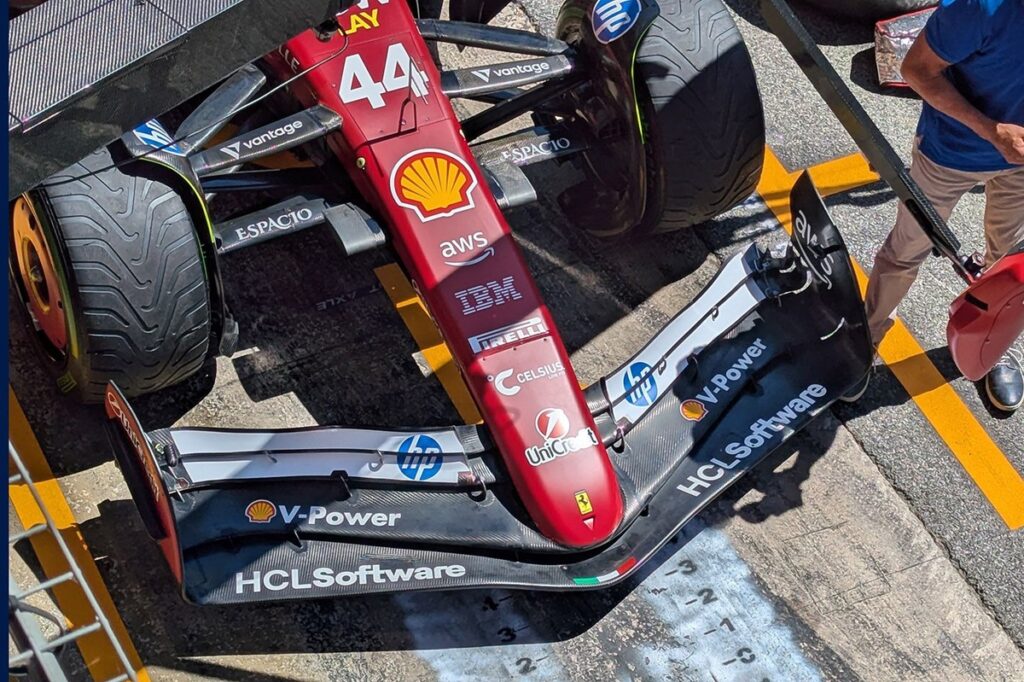Recent developments in Formula 1 have seen teams unveiling innovative solutions for their front wing designs to comply with the latest technical regulations introduced ahead of the Spanish Grand Prix. These modifications primarily address the new rules concerning wing flexibility, which aim to prevent teams from exploiting wing deflections to generate aerodynamic advantages.
Under the updated standards, when a 1000N load is applied to either side of the front wing, the permissible deflection has been reduced from 15mm to a maximum of 10mm. This stricter threshold has prompted teams to reinforce their wing structures, often resulting in more robust and less flexible components, although many of these changes remain within the realm of structural adjustments rather than aerodynamic innovations.
Despite the uniformity in the regulatory approach, some teams have gone beyond mere compliance, implementing subtle design tweaks to ensure their wings stay stiff under load while also attempting to regain aerodynamic efficiency lost due to the new restrictions. These efforts include minor geometry modifications and reinforcement strategies aimed at maintaining performance without risking penalties.
Team-Specific Approaches to Wing Reinforcement
For example, Ferrari has adjusted the load distribution across its front wing by making small geometric revisions, complemented by updates to the endplates to optimize airflow and meet the new load criteria. Similarly, Red Bull has made four significant alterations to its wing design, focusing on enhancing stiffness with minimal weight increase. The team’s technical team explained that these modifications were aimed at achieving the desired load characteristics through iterative design processes.
Meanwhile, McLaren and Mercedes introduced entirely new front wing configurations at Imola to align with the revised regulations. McLaren initially tested their updated wing but has yet to race it, while Mercedes has already deployed its new design, which features increased stiffness and refined aerodynamics.
Structural and Aerodynamic Enhancements Across Teams
Aston Martin has opted for structural reinforcement of its existing wing design without altering the fundamental geometry, instead focusing on refining the endplate edges to improve overall efficiency. Alpine has not announced any new wing updates, suggesting their previous design either met the new standards or was deemed sufficient without further modifications. Haas has also indicated that their wing adjustments are primarily structural, with team members noting that they have not exploited wing flex as aggressively as their rivals.
In contrast, Racing Point (formerly Racing Bulls) has introduced a completely redesigned nose and wing assembly. Their new nose features a downward curve to better channel airflow beneath the car, while the central section has been reduced to enhance inboard load generation. These changes aim to optimize aerodynamic performance while adhering to the flexing restrictions.
Williams has also made concurrent updates, including modifications to the rear wing flap geometry and endplate profiles. These adjustments are intended to improve airflow around the brake ducts and underbody, contributing to better overall downforce and stability. Sauber has focused on refining the junctions of its front wing endplates to enhance local aerodynamic performance.
Additional Modifications for the Spanish GP
Ferrari has introduced a revised high-downforce rear wing, largely carried over from the previous season but with subtle tweaks to improve performance. Mercedes has similarly updated its rear wing with increased camber to boost downforce, complemented by new floor edge components and inner floor fences designed to enhance underbody efficiency.
Other teams, including Alpine and Sauber, have reported extensive updates to their floor designs, aiming to maximize aerodynamic gains within the new regulatory framework. Williams has focused on circuit-specific modifications, such as adjusting rear brake cooling ducts, while Sauber continues to refine its sidepod design to better integrate with the updated floor and wing components.
These collective efforts highlight the ongoing battle among teams to optimize aerodynamic performance while complying with the evolving technical regulations. The strategic balance between structural reinforcement and aerodynamic innovation remains central to their development programs as they prepare for the upcoming races.

